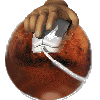- HiRISE
- Crater marking
- Crater classification
- fresh/degraded/ghost
- full*
- Other
- Pathfinder magnets*
- honeycomb search*
- Results of the pilot study
* unavailable
About this site
There are many scientific tasks that require human perception and common sense, but may not require a lot of scientific training. Identifying craters on Mars is something almost anyone can do, and classifying them by age is only a little harder.
The original pilot study (2000-2001)
From November 2000 to September 2001, we ran an experiment that showed that public volunteers (clickworkers), many working for a few minutes here and there and others choosing work work longer, can do some routine science analysis that would normally be done by a scientist or graduate student working for months on end.
- The clickworkers pilot study produced some very impressive results in 2001.
- All the activities are still up and running, although they have largely served their purpose already.
- You can mark never-before-catalogued craters in images recently acquired by MGS, which is currently in Mars orbit on a mapping mission. Please take the training session to learn how to mark craters. Then read the introduction and start marking. Note that you may need to set a size limit if the images are too big for you or your computer to deal with.
- You might try your hand at crater classification using the new richer system -- please see the training material and give it a try.
- You
can still do any of the other activities if you want to. We’re
unlikely to learn anything new from them, but you never know.
- Craters in the Viking Orbiter Mars Digital Image Mosaic have already been marked 40 or 50 times over, more than enough to prove the point, but you can do more if you want to. Be sure to try the training session.
- If you like, you can try the old fresh/degraded/ghost classification system, but we have plenty of entries already.
- The honeycomb search failed to turn up any new examples of honeycomb terrain, according to Dr. Moore. Perhaps they really don’t exist. When given the one known example they’ve already seen (but upside down), 69% of clickworkers identified it as honeycomb. The most common false identifications are layered deposits in the polar regions being mistaken for honeycomb.
- You can still try Mars Pathfinder magnet images just for fun.
 Results: Mars age map produced directly from clickworker inputs
Results: Mars age map produced directly from clickworker inputs
Clickworker crater-marking inputs have been combined into a map of the ages of different regions of Mars. It agrees fairly closely with what was already known from traditional crater counting. The image above compares the two versions. A higher-resolution one and more details are available.


